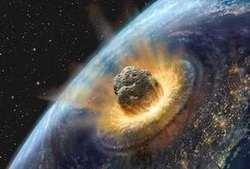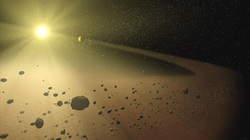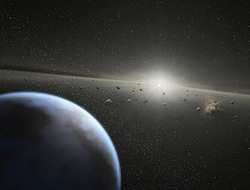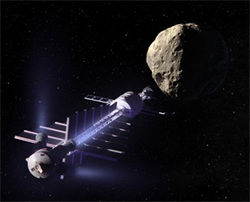Meteorite Impact

One of the most popular theories about how our planet will be destroyed is the one about asteroids. Many asteroids of many shapes and sizes hit our planet. About 3,000 every year hit our planet, but basically all of them are so small that they won't do anything but make little scars in the ground. However, there might be some objects that might pose a threat to our planet.
To understand how our planet is in threat from asteroids, imagine our solar system as an intergalactic dodge-ball game. The opponents are the Oort cloud, a huge group of asteroids that circle outside our solar system. Occasionally, they throw asteroids at our solar system. Mostly the asteroids that enter our solar system are burnt up by the heat of the sun.
The ones that are left are usually attracted by the bigger gas planets towards the outside of the solar system, like Jupiter. The ones that are left might hit our planet.
However, the asteroids that come really close to our planet, also come close to our sun. The sun is like a star dodge-ball player. The sun either burns up the asteroid, or uses its gravity to fling the asteroid back to the Oort Cloud, therefore continuing the dodge-ball game.
To understand how our planet is in threat from asteroids, imagine our solar system as an intergalactic dodge-ball game. The opponents are the Oort cloud, a huge group of asteroids that circle outside our solar system. Occasionally, they throw asteroids at our solar system. Mostly the asteroids that enter our solar system are burnt up by the heat of the sun.
The ones that are left are usually attracted by the bigger gas planets towards the outside of the solar system, like Jupiter. The ones that are left might hit our planet.
However, the asteroids that come really close to our planet, also come close to our sun. The sun is like a star dodge-ball player. The sun either burns up the asteroid, or uses its gravity to fling the asteroid back to the Oort Cloud, therefore continuing the dodge-ball game.
What's the difference between asteroids, meteors or meteorites?

Many people assume that asteroids, meteors and meteorites are the same thing. They l actually aren’t.
Asteroids are like mini planets that orbit the Sun. They from a kilometre across, or up to 700 kilometres long! There are hundreds of thousands of asteroids in the solar system, and most asteroids are located in the asteroid belt sperating Mars and Jupiter. Recently, scientists have planted probes on asteroids to study the chemical and organic matter to determine if an asteroid crashing into our planet started life on our planet as we know it.
Asteroids that come close to our planet are called Apollo asteroids, and are usually numbered or named after famous people or astronomers.
Meteors are chunks of asteroids and comets that fall into our planet's orbit. They burn up in the atmosphere. Our planet passes through meteor showers at certain times of the year, including January 3, August 12 and December 14. Millions of meteors go into the atmosphere of our planet every year, but most of them burn up in the atmosphere.
Asteroids are like mini planets that orbit the Sun. They from a kilometre across, or up to 700 kilometres long! There are hundreds of thousands of asteroids in the solar system, and most asteroids are located in the asteroid belt sperating Mars and Jupiter. Recently, scientists have planted probes on asteroids to study the chemical and organic matter to determine if an asteroid crashing into our planet started life on our planet as we know it.
Asteroids that come close to our planet are called Apollo asteroids, and are usually numbered or named after famous people or astronomers.
Meteors are chunks of asteroids and comets that fall into our planet's orbit. They burn up in the atmosphere. Our planet passes through meteor showers at certain times of the year, including January 3, August 12 and December 14. Millions of meteors go into the atmosphere of our planet every year, but most of them burn up in the atmosphere.
What will happen if an asteroid hits our planet?

It is highly unlikely that an asteroid will even come close to our planet, but this is what scientists believe will happen. First, satellites orbiting our planet will detect the asteroid. By then it would be probably be too late, as our planet has only about six months to prepare for an asteroid impact. When the official report reaches citizens, there will be a mass outbreak of panic. Public services will be shut down and the economy would fall apart. Many people will quit their jobs and move out of cities into areas where they believe are safe. The governments across the world will probably build shelters underground or in the air to prevent humans from being in the direct impact zone of the asteroid.
By now, the asteroid would’ve been extremely close to our planet or already repelled. Hopefully repelled. However, where the asteroid lands will cause different catastrophes. If it lands in the sea, the initial impact of the asteroid would instantly vaporise all the sea creatures in the area. It would also release a whole lot of sand, rock and coral into the air. Then the impact would send a huge amount of water gushing into the air like a geyser. A horribly big geyser.
The water in beaches would decrease dramatically, with the water levels of our planet dropping. Where there were sea and all kinds of coral and sea creatures would be just kilometres of sand. Then a shockwave sent out by the impact would destroy several thousands of kilometres of buildings along the coast and cause major fires inland. A few minutes after the impact, the geyser of water would begin to fall down towards our planet due to gravity. When this happens, the water would gush at about 220 kilometres an hour towards land. This would cause tidal waves on a global scale. The quadrillions of tons of water swamping the land would instantly destroy the houses along the coast that survived the shockwaves and fires.
Then the waves would head inland, quenching fires but also killing thousands in the massive flood. By then the fires would have sped inland, obliterating people, animals, plants and buildings. The tidal waves would’ve caught up with the fires after a few minutes, wiping out basically everything. Then the deadly bits of rock, coral and sand would start to bombard the rest of the land, setting fire to whatever was left or just increasing the amount of carnage caused by the asteroid. After half an hour, the waves would have retreated back to normal.
However, the shockwave would have triggered the tectonic plates, causing earthquakes and volcanic eruptions. Then the gas released by the impact would choke people and block out all visibility. The gas will also block out the sun, triggering global freezing. The end result? Barren land, with gas blocking the sky and all life wiped out. You gotta feel sorry for the dinosaurs.
By now, the asteroid would’ve been extremely close to our planet or already repelled. Hopefully repelled. However, where the asteroid lands will cause different catastrophes. If it lands in the sea, the initial impact of the asteroid would instantly vaporise all the sea creatures in the area. It would also release a whole lot of sand, rock and coral into the air. Then the impact would send a huge amount of water gushing into the air like a geyser. A horribly big geyser.
The water in beaches would decrease dramatically, with the water levels of our planet dropping. Where there were sea and all kinds of coral and sea creatures would be just kilometres of sand. Then a shockwave sent out by the impact would destroy several thousands of kilometres of buildings along the coast and cause major fires inland. A few minutes after the impact, the geyser of water would begin to fall down towards our planet due to gravity. When this happens, the water would gush at about 220 kilometres an hour towards land. This would cause tidal waves on a global scale. The quadrillions of tons of water swamping the land would instantly destroy the houses along the coast that survived the shockwaves and fires.
Then the waves would head inland, quenching fires but also killing thousands in the massive flood. By then the fires would have sped inland, obliterating people, animals, plants and buildings. The tidal waves would’ve caught up with the fires after a few minutes, wiping out basically everything. Then the deadly bits of rock, coral and sand would start to bombard the rest of the land, setting fire to whatever was left or just increasing the amount of carnage caused by the asteroid. After half an hour, the waves would have retreated back to normal.
However, the shockwave would have triggered the tectonic plates, causing earthquakes and volcanic eruptions. Then the gas released by the impact would choke people and block out all visibility. The gas will also block out the sun, triggering global freezing. The end result? Barren land, with gas blocking the sky and all life wiped out. You gotta feel sorry for the dinosaurs.
How can we stop an asteroid hitting our planet?

Many people want to know how to repel an asteroid. There are actually many ways that us humans can destroy or alter an asteroid. Many people also think that if we got all of the bombs in the world, you know, all the hydrogen bombs, nuclear bombs, hyper-sonic bombs, hand grenades and mines in the world, and attach to an asteroid, it won’t work. All the bombs will do is put up a pretty fireworks display and move the asteroid a little bit. If we managed to blow apart the asteroid, that would still be a stupid idea, as all of the iron, steel and rock in the asteroid would fall towards our planet, so instead of one big asteroid, we will have several asteroids hurtling towards our planet.
The first idea is to get all the bombs in the world, you know, all the hydrogen bombs, nuclear bombs, hyper-sonic bombs, hand grenades and mines in the world, and attach to an asteroid, it will work. I know, contradicting what I said above. However, just remember that I said that we could make the asteroid move a little bit. This may be enough to completely alter the course of the asteroid (oh, and I’m pretty keen in seeing the fireworks display). Altering the course would send the asteroid completely off target, therefore saving our planet (who knew bombs could actually save people instead of killing them?).
The second method is to attach a rocket to the asteroid. This has been done before, but is very risky and expensive if the operation goes wrong. In fact, even probes landing on asteroids have 70% chance of failure, either by blowing up when hitting the asteroid or going completely off target. However, when the rocket reaches the asteroid, the rocket gives it a big push with its thrusters, doing the same thing as method one.
The third is to paint the asteroid white. This may sound incredibly stupid, but this can actually work very well. The Yarkovsky effect is what helps this method work. The Yarkovsky effect is the effect of the colour black absorbing heat and the colour white repelling it. Therefore if we painted the asteroid white, the biggest thing in the solar system would repel it: The Sun.
The fourth method is to send up a probe to try and to persuade the asteroid out of the way using its gravity. Unlike other methods, this method is very slow and requires a few years. The B612 Foundation, a group of scientists, engineers and astronauts, thought of this idea.
Handy Links
These are some handy links I found while searching the internet. However, remember that these may not always be reliable. Copy paste these URLs onto your address bar on top of your Firefox or Internet Explorer or Safari or whatever you use as your internet. Then press the Enter key or the Return key to access the website.
http://impact.ese.ic.ac.uk/ImpactEffects/
This website calculates many aspects of what will happen if an asteroid hit Earth, depending on the size of it. This website determines things like the crater size or the impact on the climate.
http://www.meteorites.com.au/found.html
This website can help you identify a meteorite. If you find one, good job! This guide also provides you with pictures of meteorites, so now you can start your career as a certified meteorite hunter!
http://impact.ese.ic.ac.uk/ImpactEffects/
This website calculates many aspects of what will happen if an asteroid hit Earth, depending on the size of it. This website determines things like the crater size or the impact on the climate.
http://www.meteorites.com.au/found.html
This website can help you identify a meteorite. If you find one, good job! This guide also provides you with pictures of meteorites, so now you can start your career as a certified meteorite hunter!
Likelihood
The likelihood? Many meteorites hit our planet everyday. They are the small ones that will not do any damage, at most only cause a minor hole. So I’ll have to give the chances of an asteroid hitting our planet 100% chance. Scary, I know, but that’s only for the really small and common ones. The chances of a big killer one that will wipe out our whole planet, normally, is one in 7000. At most one in 600. So if you were panicking because the thought of an asteroid hitting our planet, don’t be. Anyway, there are many possible ways to repel them. Considering all of this, my likelihood rating is:
10/10 for little asteroids that hit our planet everyday and’
2/10 for big killer ones that can eradicate mankind as we know it.
10/10 for little asteroids that hit our planet everyday and’
2/10 for big killer ones that can eradicate mankind as we know it.
